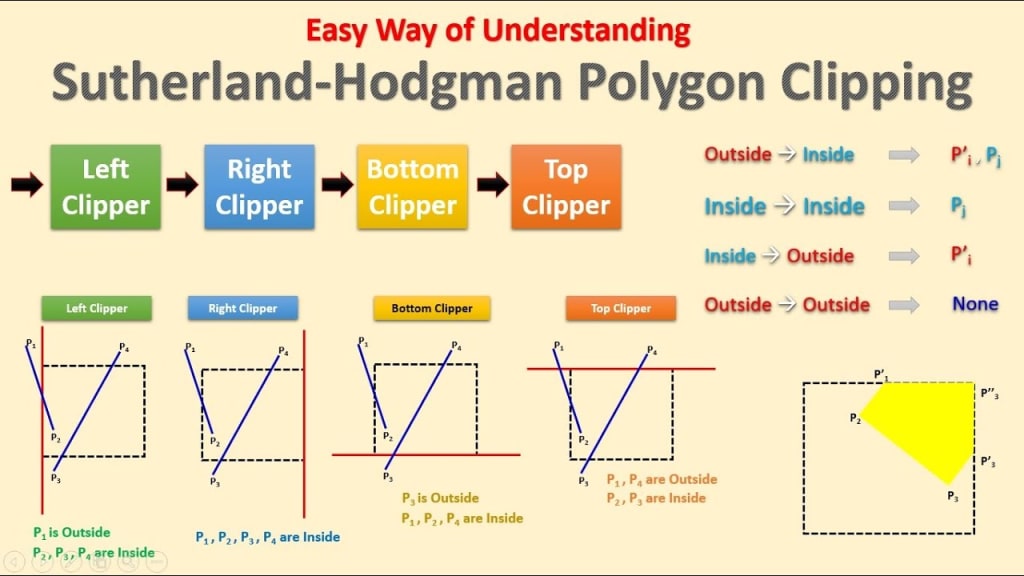What is Polygon Clipping in Computer Graphics?
Understanding Polygon Clipping in Computer Graphics: Techniques and Applications

Introduction
Polygon clipping is a fundamental technique in computer graphics, essential for rendering scenes efficiently and correctly. It involves cutting or "clipping" polygons to fit within a specified rectangular area known as the clipping window or viewport. This process ensures that only the visible portions of polygons are processed and displayed, which optimizes rendering performance and improves the accuracy of graphical representations.
Clipping Window and Types
The clipping window is typically defined by its boundaries: left, right, top, and bottom. Clipping is performed against these boundaries to eliminate parts of the polygon that fall outside the visible area. There are several types of clipping, but the two most common are:
1. 2D Clipping:
Deals with two-dimensional graphics, where polygons are clipped against a rectangular window.
2. 3D Clipping:
Extends the concept to three dimensions, often involving a view frustum in 3D space.
Algorithms for Polygon Clipping
Numerous algorithms have been developed for polygon clipping, each with its strengths and weaknesses. Some of the most widely used include:
1. Sutherland-Hodgman Algorithm
2. Weiler-Atherton Algorithm
3. Cohen-Sutherland Algorithm
4. Liang-Barsky Algorithm
Sutherland-Hodgman Algorithm
The Sutherland-Hodgman algorithm is one of the most popular methods for polygon clipping. It works by processing the polygon edges against each boundary of the clipping window sequentially. Here’s a step-by-step breakdown:
1. Initialization:
- Start with the initial list of polygon vertices.
2. Edge Processing: For each edge of the clipping window (left, right, top, bottom):
- Iterate over the polygon's vertices.
- For each pair of adjacent vertices (defining an edge of the polygon), determine their position relative to the clipping edge.
- Based on their positions (inside or outside), determine how to clip the edge:
- If both vertices are inside, add the second vertex to the output list.
- If the first vertex is inside and the second is outside, add the intersection point with the clipping edge to the output list.
- If the first vertex is outside and the second is inside, add the intersection point and the second vertex to the output list.
- If both vertices are outside, add nothing to the output list.
3. Result:
After processing against all clipping edges, the final output list contains the vertices of the clipped polygon.
Weiler-Atherton Algorithm
The Weiler-Atherton algorithm is more complex and versatile, particularly suited for clipping concave polygons or handling complex intersection scenarios. It constructs the clipped polygon by traversing and integrating parts of both the polygon and clipping window:
1. Edge Intersections:
Identify and record all intersections between the polygon edges and the clipping window boundaries.
2. Vertex Classification:
Classify vertices as inside or outside the clipping window.
3. Polygon Construction:
Use the intersection points and vertex classifications to build the clipped polygon by traversing through both the polygon and the clipping window boundaries, switching paths at intersection points.
Practical Considerations
When implementing polygon clipping, several practical considerations must be taken into account:
1. Precision and Robustness:
Numerical precision is crucial. Floating-point inaccuracies can lead to incorrect clipping results, such as missing edges or incorrectly classified vertices.
2. Performance:
Clipping algorithms should be optimized for performance, especially when dealing with complex scenes with many polygons.
3. Handling Special Cases:
Special cases, such as polygons completely inside or outside the clipping window, or edges exactly on the clipping boundary, need careful handling to avoid errors.
Applications
Polygon clipping is widely used in various applications within computer graphics, including:
1. Rendering Engines:
Essential for real-time rendering in video games and simulations.
2. Computer-Aided Design (CAD):
Used for displaying only relevant parts of complex models.
3. Geographic Information Systems (GIS):
Clipping geographic data to fit within map boundaries.
4. Graphical User Interfaces (GUI):
Clipping widgets and windows to fit within the display area.
Conclusion
Polygon clipping is a critical operation in computer graphics, ensuring that only visible parts of polygons are processed and displayed. Various algorithms, such as Sutherland-Hodgman and Weiler-Atherton, provide robust solutions for different clipping scenarios.
Understanding and implementing efficient polygon clipping techniques is vital for optimizing rendering performance and accuracy in a wide range of graphical applications.
About the Creator
Pushpendra Sharma
I am currently working as Digital Marketing Executive in Tutorials and Examples.
Enjoyed the story? Support the Creator.
Subscribe for free to receive all their stories in your feed. You could also pledge your support or give them a one-off tip, letting them know you appreciate their work.






Comments (2)
Hey, just wanna let you know that this is more suitable to be posted in the 01 community 😊
I've never heard about it. Thank you.